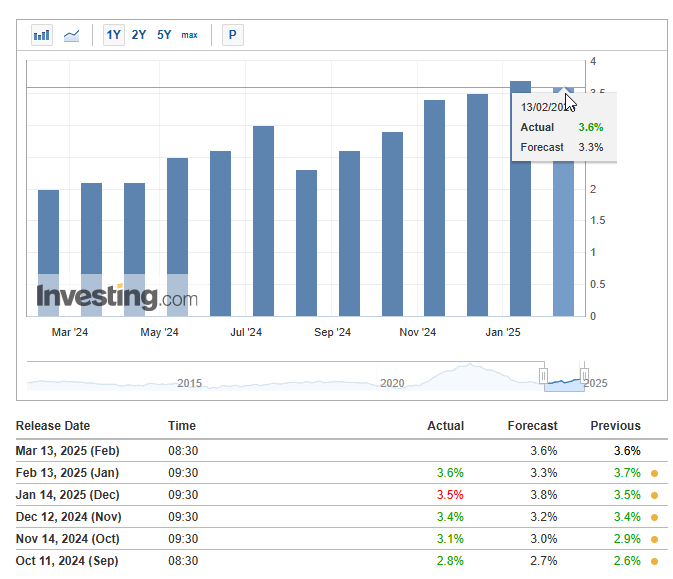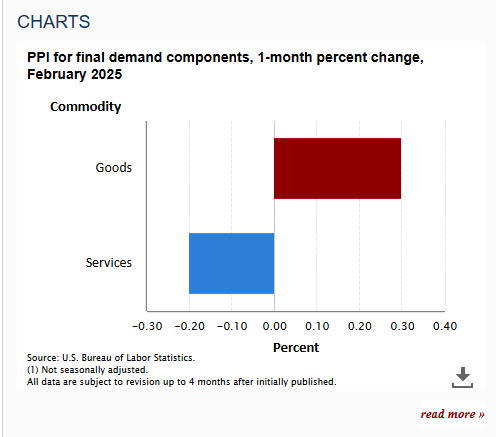US Core PPI falls to 3.4% – Lower Than Expectations

Share:
The Core PPI inflation data, at the time of writing, showed a 0.3% rise in January, and also that there were some key indicators pointing to sustained pressure. The PPI report revealed year-over-year figures at a value of 3.6%, positioning above the forecast of 3.3% across economic sectors. This represents a modest drop from a value of 3.7% back in December, but continues to show some persistent inflation pressure in the economic calendar for early 2025. What do you think this means for your investments? Let’s find out!
JUST IN:
— Watcher.Guru (@WatcherGuru) March 13, 2025US Core PPI falls to 3.4%, lower than expectations.
Also Read: Wall Street Crash: Who Got Wrecked in the $320B Crash—While Buffett Cashed In?
Analyzing Core PPI Trends and Their Impact on Inflation and the Economy

The Producer Price Index for final demand increased 0.4% in January, with services rising 0.3% and goods advancing 0.6%. Core PPI has maintained an upward trajectory since September 2024’s 2.8%, suggesting persistent production pipeline inflation.

The U.S. Bureau of Labor Statistics reported:
“When producers pay more for goods and services, they are more likely to pass the higher costs to the consumer, so PPI is thought to be a leading indicator of consumer inflation.”
Also Read: Market Dip Alert: 3 Bargain Stocks with High Growth Potential
Analysts at Investing.com have said:
“Headline U.S. producer prices increased at a hotter-than-anticipated pace in January, in the latest sign of lingering inflationary pressures that are likely to dent bets for possible rate cuts.”

Services for intermediate demand actually fell about 0.2% in January, you know, while processed goods increased a solid 1.0% and unprocessed goods really jumped up 5.5%. Business loans, interestingly enough, dropped a significant 7.7%, while truck transportation of freight rose 1.3%, revealing those varied sectoral impacts we’ve been watching.
Also Read: BNB Price Surge: $580 Breakthrough with 6.19% Rise – Key Drivers
February 2025 Data

US Core PPI falls to 3.4%, which is lower than expectations. The chart shows PPI for final demand components with a 1-month percent change for February 2025. Goods registered a positive change of approximately 0.3%, while services showed a smaller increase of about 0.1%.

Market expectations for rate cuts have shifted after January’s data. The Fed faces a tougher path due to persistent producer price pressures, which typically come before consumer inflation trends that markets will watch closely in upcoming releases.
US Core PPI falls to 3.4% – Lower Than Expectations

Share:
The Core PPI inflation data, at the time of writing, showed a 0.3% rise in January, and also that there were some key indicators pointing to sustained pressure. The PPI report revealed year-over-year figures at a value of 3.6%, positioning above the forecast of 3.3% across economic sectors. This represents a modest drop from a value of 3.7% back in December, but continues to show some persistent inflation pressure in the economic calendar for early 2025. What do you think this means for your investments? Let’s find out!
JUST IN:
— Watcher.Guru (@WatcherGuru) March 13, 2025US Core PPI falls to 3.4%, lower than expectations.
Also Read: Wall Street Crash: Who Got Wrecked in the $320B Crash—While Buffett Cashed In?
Analyzing Core PPI Trends and Their Impact on Inflation and the Economy

The Producer Price Index for final demand increased 0.4% in January, with services rising 0.3% and goods advancing 0.6%. Core PPI has maintained an upward trajectory since September 2024’s 2.8%, suggesting persistent production pipeline inflation.

The U.S. Bureau of Labor Statistics reported:
“When producers pay more for goods and services, they are more likely to pass the higher costs to the consumer, so PPI is thought to be a leading indicator of consumer inflation.”
Also Read: Market Dip Alert: 3 Bargain Stocks with High Growth Potential
Analysts at Investing.com have said:
“Headline U.S. producer prices increased at a hotter-than-anticipated pace in January, in the latest sign of lingering inflationary pressures that are likely to dent bets for possible rate cuts.”

Services for intermediate demand actually fell about 0.2% in January, you know, while processed goods increased a solid 1.0% and unprocessed goods really jumped up 5.5%. Business loans, interestingly enough, dropped a significant 7.7%, while truck transportation of freight rose 1.3%, revealing those varied sectoral impacts we’ve been watching.
Also Read: BNB Price Surge: $580 Breakthrough with 6.19% Rise – Key Drivers
February 2025 Data

US Core PPI falls to 3.4%, which is lower than expectations. The chart shows PPI for final demand components with a 1-month percent change for February 2025. Goods registered a positive change of approximately 0.3%, while services showed a smaller increase of about 0.1%.

Market expectations for rate cuts have shifted after January’s data. The Fed faces a tougher path due to persistent producer price pressures, which typically come before consumer inflation trends that markets will watch closely in upcoming releases.









